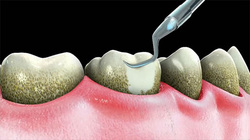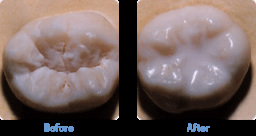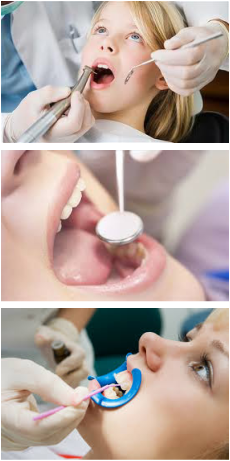
Prophylaxis
Prohylaxis or cleaning of the teeth by a dentist or dental hygienist, including removal of plaque, materia alba, calculus, and extrinsic stains; done as a preventive measure for control of gingivitis. Teeth cleaning can be done by hand instrument along with high speed cavitron with ultrasonic speed. The advantages of using ultrasonic are less friction and a more thorough cleaning with less chair side time. After your cleaning your hygienist will polish your teeth to get rid of any external stains. Please discuss with your hygienist or dentist if you do have any individual preferences.
Prohylaxis or cleaning of the teeth by a dentist or dental hygienist, including removal of plaque, materia alba, calculus, and extrinsic stains; done as a preventive measure for control of gingivitis. Teeth cleaning can be done by hand instrument along with high speed cavitron with ultrasonic speed. The advantages of using ultrasonic are less friction and a more thorough cleaning with less chair side time. After your cleaning your hygienist will polish your teeth to get rid of any external stains. Please discuss with your hygienist or dentist if you do have any individual preferences.

Sealants
Sometimes brushing is not enough, especially when it comes to those hard-to-reach spots in your mouth. It is difficult for your toothbrush to get in-between the small cracks and grooves on your teeth. If left alone, those tiny areas can develop tooth decay. Sealants give your teeth extra protection against decay and help prevent cavities. Dental sealants are a plastic resin that bonds and hardens in the deep grooves on your tooth’s surface. When a tooth is sealed, the tiny grooves become smooth, and are less likely to harbor plaque. With sealants, brushing your teeth becomes easier and more effective against tooth decay. Sealants are typically applied to children’s teeth as a preventive measure after the permanent teeth have erupted as a way to prevent tooth decay. However, adults also can receive sealants on healthy teeth. It is more common to seal "permanent" teeth rather than "baby" teeth, but every patient has unique needs, and your dentist will recommend sealants on a case-by-case basis. Sealants last from three to five years, although it is fairly common to see adults with sealants still intact from their childhood. A dental sealant only provides protection when it is fully intact, so if your sealants come off, let your dentist know, and schedule an appointment for your teeth to be re-sealed.
Sometimes brushing is not enough, especially when it comes to those hard-to-reach spots in your mouth. It is difficult for your toothbrush to get in-between the small cracks and grooves on your teeth. If left alone, those tiny areas can develop tooth decay. Sealants give your teeth extra protection against decay and help prevent cavities. Dental sealants are a plastic resin that bonds and hardens in the deep grooves on your tooth’s surface. When a tooth is sealed, the tiny grooves become smooth, and are less likely to harbor plaque. With sealants, brushing your teeth becomes easier and more effective against tooth decay. Sealants are typically applied to children’s teeth as a preventive measure after the permanent teeth have erupted as a way to prevent tooth decay. However, adults also can receive sealants on healthy teeth. It is more common to seal "permanent" teeth rather than "baby" teeth, but every patient has unique needs, and your dentist will recommend sealants on a case-by-case basis. Sealants last from three to five years, although it is fairly common to see adults with sealants still intact from their childhood. A dental sealant only provides protection when it is fully intact, so if your sealants come off, let your dentist know, and schedule an appointment for your teeth to be re-sealed.

Fluoride Therapy
Fluoride is a natural mineral that makes your teeth strong and helps prevent cavities. At the dentist's office, a fluoride gel or foam will be applied to your teeth. Most dental offices offer fluoride treatments with flavoring, like bubble gum or grape. The fluoride treatment will take about 1 to 4 minutes. The dental hygienist will probably tell you not to eat or drink anything (including water) for 30 minutes after the fluoride treatment.
Fluoride is a natural mineral that makes your teeth strong and helps prevent cavities. At the dentist's office, a fluoride gel or foam will be applied to your teeth. Most dental offices offer fluoride treatments with flavoring, like bubble gum or grape. The fluoride treatment will take about 1 to 4 minutes. The dental hygienist will probably tell you not to eat or drink anything (including water) for 30 minutes after the fluoride treatment.